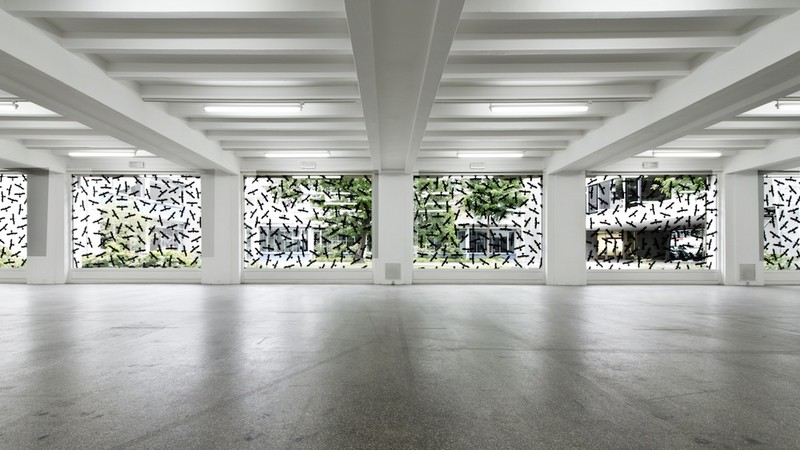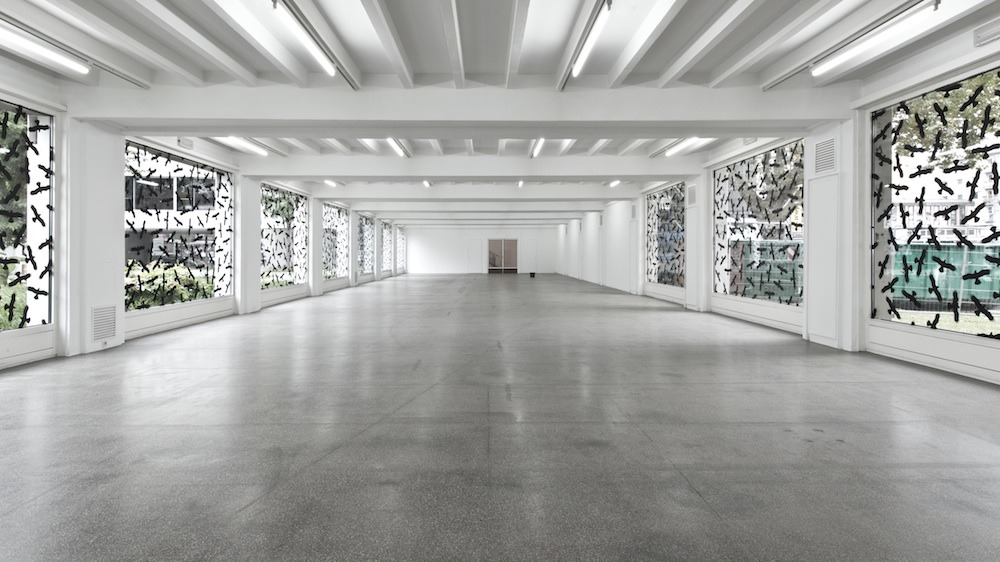Ceal Floyer
Laufzeit
06 Sep - 20 Oct 2013

Ceal Floyer, exhibition view, Kölnischer Kunstverein, 2013. Courtesy: Ceal Floyer / Esther Schipper, Berlin / Lisson Gallery, London / 303 Gallery, New York. Foto: Amelie Proché © Kölnischer Kunstverein, 2013

Ceal Floyer, exhibition view, Kölnischer Kunstverein, 2013. Courtesy: Ceal Floyer / Esther Schipper, Berlin / Lisson Gallery, London / 303 Gallery, New York. Foto: Amelie Proché © Kölnischer Kunstverein, 2013
The Berlin-based artist Ceal Floyer, who has attracted international attention in recent years with her astute and mostly poetic conceptual art, is presenting a site-specific exhibition at the Kölnischer Kunstverein that not only reflects the special architectural conditions of the building, but also provides an insight into her artistic practice.
The intervention that Ceal Floyer has made in the large exhibition hall of the Kölnischer Kunstverein seems quite comprehensive, even if the means for it actually seem rather minimal. Countless stickers of black bird silhouettes, as we know them from the glazed facades of public buildings, have been installed on the pavilion’s large windows. They are the shadowy outlines of buzzards, which are supposed to protect real birds from flying against the transparent panes by their deterrent effect. Contrary to the usual installation method, which provides for sporadic placement of the stickers, the buzzards are placed close together in the context of Ceal Floyer’s 2002 work Warning Birds – which is the central work of the exhibition. The view through the glass panes is restricted to such an extent that the windows can hardly fulfill their actual function. Due to their specific placement, the birds almost have an ornamental character, which occasionally distracts from the fact that the work also evokes memories of the well-known attack scenes from Alfred Hitchcock’s classic The Birds in a haunting way. By changing familiar parameters, Floyer achieves a fundamental shift in meaning that allows for a wide range of associations, even if the work, as its title suggests, shows nothing but warning birds
The subliminal humour, which can be understood in the work through the seemingly absurd increase in the Warning Birds’ commission, is combined with a large number of Floyer’s works, so that it can almost be seen as a characteristic of her practice. This particular form of humor also characterizes the 1999 work Bucket, which Floyer deliberately integrated into the context of the Warning Birds’ expansive installation. The work consists of an ordinary black bucket, which seems quite surprising and perhaps even a little out of place within the exhibition, so that uncertainty creeps in as to whether the container was left behind by mistake. At regular intervals, a sound becomes perceptible that is reminiscent of the constant dripping of a water leak. Inevitably, the observer’s gaze is directed towards the hall ceiling where the leak could be suspected. However, there are no indications of water damage in this area. The explanation for the unusual noise is ultimately found inside the bucket. A portable CD player and a box are arranged in this bucket, which produce the irritating sound. None of the devices is hidden and the conditions for the illusion are thus immediately apparent.
Even though Floyer’s work refers to the tradition of deception, which has long been anchored in art history, it seems to contradict it in a certain way. Her work creates an illusion in order to reveal its foundations in the next moment and to dissolve them again.
The work Rock Paper Scissors, created in 2013 and complementing the Bucket within the installation Warning Birds, which functions as a framework, so to speak, manages without any tricks of deception. The work consists of three square picture panels, each showing a rock, a paper and a pair of scissors, thus referring to the widespread game of the same name, in which the hands are used to reproduce the various signs. The work is based on images that Floyer did not produce himself, but rather as found footage, as found material simply adopted. The three motifs that make up the work illustrate on the one hand the title of the work and on the other hand refer to the system of signs and meanings linked to real objects, with which rules and actions are connected in the world of play. The simultaneous visibility of all three objects contradicts the conditions of the game and thus calls into question the connection between real objects and the sign system behind them, so that the work can also be read as a still life. Floyer’s Rock Paper Scissors thus revolves around the relationship between language, signs and images.
But Ceal Floyer’s exhibition at the Kölnischer Kunstverein does not begin in the pavilion of the Riphahn building. As soon as visitors enter the building’s large and bright entrance doors, they are greeted by a soft, but thoroughly atmospheric music that draws them to the cinema’s double doors. In the darkened auditorium he is then confronted with Floyer’s film work Untitled Credit Roll, made in 2013, which in a way gives the visitor the impression of having arrived late for a screening. White, abstract and partly cloud-like formations and shapes slowly run from the lower to the upper edge of the screen and, in interaction with the music, refer to the classic credits of a film. The lettering, names and functional designations are blurred and can no longer be read, so that one could suspect that the lens of the film projector has been misaligned. The often overlooked end of a film screening, where many viewers have already left the cinema auditorium, is brought to the fore by the artist as part of the work and elevated to the status of an actual attraction.
Floyer reverses the meaning of things and directs attention from a major to a minor matter. The sophistication and ingenuity she displays in this process proves the artist to be a master of her profession and justifies the special quality of her diverse practice.
A catalogue will be published to accompany the exhibition.
The intervention that Ceal Floyer has made in the large exhibition hall of the Kölnischer Kunstverein seems quite comprehensive, even if the means for it actually seem rather minimal. Countless stickers of black bird silhouettes, as we know them from the glazed facades of public buildings, have been installed on the pavilion’s large windows. They are the shadowy outlines of buzzards, which are supposed to protect real birds from flying against the transparent panes by their deterrent effect. Contrary to the usual installation method, which provides for sporadic placement of the stickers, the buzzards are placed close together in the context of Ceal Floyer’s 2002 work Warning Birds – which is the central work of the exhibition. The view through the glass panes is restricted to such an extent that the windows can hardly fulfill their actual function. Due to their specific placement, the birds almost have an ornamental character, which occasionally distracts from the fact that the work also evokes memories of the well-known attack scenes from Alfred Hitchcock’s classic The Birds in a haunting way. By changing familiar parameters, Floyer achieves a fundamental shift in meaning that allows for a wide range of associations, even if the work, as its title suggests, shows nothing but warning birds
The subliminal humour, which can be understood in the work through the seemingly absurd increase in the Warning Birds’ commission, is combined with a large number of Floyer’s works, so that it can almost be seen as a characteristic of her practice. This particular form of humor also characterizes the 1999 work Bucket, which Floyer deliberately integrated into the context of the Warning Birds’ expansive installation. The work consists of an ordinary black bucket, which seems quite surprising and perhaps even a little out of place within the exhibition, so that uncertainty creeps in as to whether the container was left behind by mistake. At regular intervals, a sound becomes perceptible that is reminiscent of the constant dripping of a water leak. Inevitably, the observer’s gaze is directed towards the hall ceiling where the leak could be suspected. However, there are no indications of water damage in this area. The explanation for the unusual noise is ultimately found inside the bucket. A portable CD player and a box are arranged in this bucket, which produce the irritating sound. None of the devices is hidden and the conditions for the illusion are thus immediately apparent.
Even though Floyer’s work refers to the tradition of deception, which has long been anchored in art history, it seems to contradict it in a certain way. Her work creates an illusion in order to reveal its foundations in the next moment and to dissolve them again.
The work Rock Paper Scissors, created in 2013 and complementing the Bucket within the installation Warning Birds, which functions as a framework, so to speak, manages without any tricks of deception. The work consists of three square picture panels, each showing a rock, a paper and a pair of scissors, thus referring to the widespread game of the same name, in which the hands are used to reproduce the various signs. The work is based on images that Floyer did not produce himself, but rather as found footage, as found material simply adopted. The three motifs that make up the work illustrate on the one hand the title of the work and on the other hand refer to the system of signs and meanings linked to real objects, with which rules and actions are connected in the world of play. The simultaneous visibility of all three objects contradicts the conditions of the game and thus calls into question the connection between real objects and the sign system behind them, so that the work can also be read as a still life. Floyer’s Rock Paper Scissors thus revolves around the relationship between language, signs and images.
But Ceal Floyer’s exhibition at the Kölnischer Kunstverein does not begin in the pavilion of the Riphahn building. As soon as visitors enter the building’s large and bright entrance doors, they are greeted by a soft, but thoroughly atmospheric music that draws them to the cinema’s double doors. In the darkened auditorium he is then confronted with Floyer’s film work Untitled Credit Roll, made in 2013, which in a way gives the visitor the impression of having arrived late for a screening. White, abstract and partly cloud-like formations and shapes slowly run from the lower to the upper edge of the screen and, in interaction with the music, refer to the classic credits of a film. The lettering, names and functional designations are blurred and can no longer be read, so that one could suspect that the lens of the film projector has been misaligned. The often overlooked end of a film screening, where many viewers have already left the cinema auditorium, is brought to the fore by the artist as part of the work and elevated to the status of an actual attraction.
Floyer reverses the meaning of things and directs attention from a major to a minor matter. The sophistication and ingenuity she displays in this process proves the artist to be a master of her profession and justifies the special quality of her diverse practice.
A catalogue will be published to accompany the exhibition.
